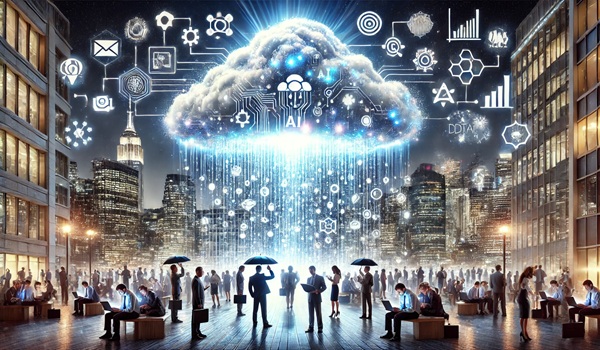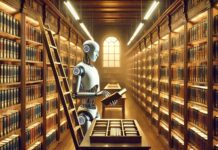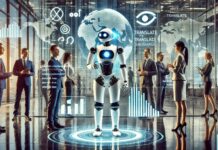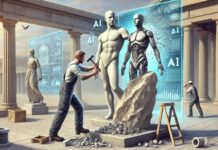Each week we find a new topic for our readers to learn about in our AI Education column.
We’re going to aim high on AI Education this week. It’s wonderful to be back writing this column after a little vacation, as this is as great an education and review for a writer and editor as it is for reader and audience. This time around, we’re going to talk about clouds. Not just clouds, but “THE CLOUD.”
Time for an interlude—most of us have been using the so-called “cloud” for a while and probably have a pretty good idea, generally speaking, of what it means, but I do think there are some misconceptions that we should dispel right off the bat. We call it the cloud as if it’s floating about in the air all around us as we speak and work and eat our dinners, but in reality, the vast majority of the infrastructure and technology that to this point have made the cloud work are solid, physical objects very much bound to the earth. Your Wi-Fi is not the cloud. Even today, with ubiquitous 5G and next-generation telecommunications protocols coming into being, the so-called cloud is at best a “fog.”
In simple terms, the technological cloud itself is just remote data storage and processing, which means I can access and manipulate data from my tablet, laptop or phone at my dinner table without having to keep that data on a hard drive and, in some cases, without having to use the computer processors at my dinner table to do most of the work. And that’s it. The cloud has nothing to do with how that storage and processing power is accessed—to this day most of the accessing is done over fiber optic and conventional cables.
How We Got Here
Like I’ve said, most of us have used the cloud—most of us are using cloud-based e-mail, spreadsheet, word processing and other office tools. For two decades or more, some of us have logged into work-based computers every day via a virtual private network (VPN) and a virtual desktop, and many of us still do. We’re frequently using the cloud without thinking about it through our phones and our apps. It’s probably worth understanding what’s really going on.
But there were also a couple of recent cloud-related headlines. To start on a positive note, market research from ResearchAndMarkets.com, predicts that cloud computing will become a $3.5 trillion market by 2035, growing from $766 billion in 2025, a 14.6% CAG. Yes, I know, take it with a grain of salt, it’s still a $766 billion market this year, so… make it a big grain of salt.
On the negative side of things, there was yet another big outage from major cloud providers over the last week. Several service providers were impacted when Google Cloud went down on Thursday afternoon. Given our increasing reliance on cloud infrastructure for our businesses and everyday lives—and AI’s entanglement with the cloud—we should do more to demystify it.
What Is the Cloud
The cloud has its roots in early computing—I like to date myself here, so I’ll say I vaguely recall using ridiculously obsolete UNIX light-pen terminals connected to a centralized supercomputer in the basement of a hospital early in my working life—ironically, that centralized computing concept gave birth to the remote and distributed computing that happens in the cloud. In both cases, you’re using a terminal, with data and computing power residing elsewhere, in the old case, in the basement of a hospital or some other institution, in the newer case, on the so-called cloud, distributed to one or more places geographically remote from the user.
But, if the cloud is physical, as I’ve alluded to, where and what is it? Well, over time, that basement supercomputer became a server situated in a room or a closet, which may also have eventually become a server situated on another computer in a smaller office or business, and then, those servers were moved outside the business to their own facility—which eventually became what we know today as data centers. The cloud, then, is actually in data centers, which are powered by processors not so different from the ones that run your personal computer or, more specifically, its graphics card; the cloud is also in the internet that we use to pass information between remote computers, or computers and remote data centers—the cloud is held together by cable, most of which resides in the ground.
Of course, it’s not that simple. There are different types of clouds.
Types of Clouds
- Personal—Private solutions allowing individuals to store and access data over the internet. Equipment is often owned and maintained by the individual.
- Private—Cloud environments dedicated to a single organization.
- Commercial—Cloud computing services offered to business and individuals. Most often from one of the big three cloud service providers.
- Public—offer computing services via the internet, most often provided by one of the big three
- Hybrid—combine private and public clouds
Cloud Service Structures and Specific Services
Software-as-a-Service (SaaS): Applications hosted over the internet that are accessed by users from a remote device.
Platform-as-a-Service (PaaS): Rather than offering access to a suite of hosted applications, PaaS offers companies tools and an environment in which to build and use their own applications.
Infrastructure-as-a-Service (IaaS): A cloud provider offers storage and infrastructure, the company itself is expected to create their own applications with their own resources.
Specific services can include: File Storage; File Sharing; Email; Streaming; Data backup; Hosting; Security; and AI Applications
Cloud Service Providers
The Big Three Are:
- Microsoft—Microsoft Azure
- Google—Google Cloud Platform
- Amazon—Amazon Web Services
Other significant providers include: IBM, Alibaba, Akamai Technologies, Oracle, Boomi, Red Hat, GitHub, Digital Ocean and Rackspace
What About AI?
AIaaS, or artificial intelligence as a service, is the offering of AI capabilities via cloud platforms. Google, Amazon, Microsoft, Anthropic and IGM all offer cloud AI services and platforms.
The capabilities and demands of AI are also reshaping the cloud itself. Data centers are moving towards more AI-friendly processors, not just GPUs, but AI-specific chips as well. The demand for data centers—and faster connections—is also on the increase. Next-generation AI not only demands the computing power and connectivity the cloud can provide, it needs the data that can only be stored and accessed via the cloud.
All of this puts greater demands on data centers themselves, which, in turn, puts greater demands on resources like power and water needed to keep the processors running and from melting down from the tremendous amounts of heat they generate. Hence the rush to build data centers near power generation plants and to bring decommissioned power plants back online.







